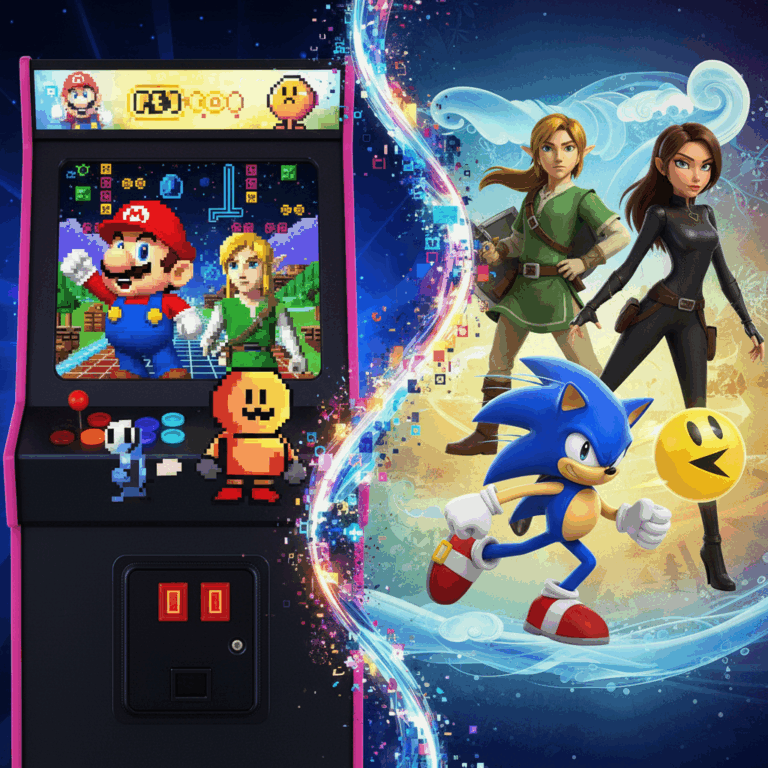General characteristics of animated films based on video games
Animated films based on video games represent a rapidly expanding genre within the audiovisual industry. These adaptations attempt to translate worlds, characters, and storylines from the game to the screen.
The main objective is to capture the essence of the video game and adapt it to a visual narrative, facing differences and challenges inherent in changing an interactive format to a linear and cinematic aesthetic one.
Definition and expansion of the genre
This genre is characterized by adapting video games into animated productions, ranging from series to feature films, opening a space where creativity and fidelity to the original material converge.
Its growth is due to the increased popularity of video games and the demand for content that exploits those universes, managing to attract both fans and new audiences through different styles.
Furthermore, these films can vary in genre, from action and adventure to horror or fantasy, which expands the narrative and visual possibilities, further enriching the animated medium.
Challenges in adapting video games to animation
A key challenge is translating the interactive experience into a fixed narrative without losing the essence and spirit that captivates players, a crucial aspect for acceptance.
There is also the challenge of balancing fidelity and creative freedom: maintaining iconic elements while adapting the script and design to an audiovisual format that requires internal consistency.
Finally, the differences in visual language and temporality between video games and animation require innovation in techniques, styles, and rhythm to offer an attractive and essentially faithful experience.
Variations in fidelity in animated adaptations
Animated video game adaptations present different levels of fidelity to the original material, from detailed reproductions to free interpretations.
This diversity reflects both creative intentions and audience demands, balancing the fidelity visual with the narrative and innovation typical of the animated medium.
High-fidelity adaptations: the Arcane case
Arcane stands out for its exceptional fidelity to the League of Legends universe, maintaining an enriched narrative and the original design of characters and settings.
The series combines innovative visuals with a plot that expands the lore without losing its essence, achieving recognition from both fans and critics.
This exemplary model successfully translates the video game into animation, respecting details and depths that many viewers appreciate.
Free versions: example Sonic the Hedgehog
Sonic the Hedgehog is characterized by freely adapting characters and iconography, while the stories and visual styles vary according to era and format.
Adaptations prioritize accessibility and entertainment over strict fidelity, modifying plots and tones to reach a wider audience.
Thus, Sonic maintains its iconic identity without being tied to a rigid continuity, favoring a flexible and contemporary approach.
Balance between visual and narrative fidelity: Warcraft: The Beginning
Warcraft: The Beginning seeks a balance between visual fidelity to the world of the video game and a simplified narrative to fit the cinematic language.
While it retains iconic settings and characters, the story is adapted to be more accessible, generating diverse opinions among dedicated fans.
This balance attempts to attract both existing fans and new viewers, although it may lead to clashes in narrative expectations.
Adaptations that prioritize atmosphere and spectacle: Resident Evil and Silent Hill
Resident Evil and Silent Hill tend to focus on recreating the atmosphere, monsters, and iconic environments, rather than maintaining a narrative faithful to the game.
These adaptations prioritize audiovisual spectacle and accessibility, often taking creative liberties to enhance the sensory experience.
As a result, they offer interpretive versions that highlight the thematic essence without strictly adhering to the original story.
Creative aspects in animated adaptations
Animated adaptations of video games allow for greater visual and narrative experimentation, freeing themselves from the constraints of realism to explore new audiovisual languages.
This creative space allows creators to incorporate unique styles and novel approaches, enriching the experience without losing the essence of the original video game.
Creative licenses and visual experimentation
Animated films can use a variety of artistic styles, from traditional 2D animation to advanced CGI, enhancing the expressiveness and dynamism of the adapted worlds.
These creative licenses allow for altering visual and structural details, always seeking an emotional impact that connects with viewers beyond the video game's script.
The use of innovative visual resources helps to highlight thematic and atmospheric elements, creating a final product that feels fresh and in line with the possibilities of the medium.
Capturing the spirit and aesthetics of the video game
Beyond simply reproducing the original, adaptations aim to preserve the atmosphere and tone that define the original experience, reflecting the identity of the video game.
This involves carefully working on the color palette, character design, and setting to evoke emotions and sensations recognizable to fans.
Thus, the animation not only represents the game, but reinterprets its spirit so that it can be enjoyed in a visual narrative typical of animated cinema.
Evaluation and reception of adaptations
The reception of animated films based on video games varies depending on how well they connect with fans and critics. Evaluation focuses on faithfulness to the source material, narrative, and visual quality.
The impact of these adaptations reflects the expectation generated by the original game and the ability of the animated product to respect or reinvent its essence.
Fan rating
Fans tend to positively value adaptations that maintain the essence and details of the game, such as characters and lore, reinforcing their emotional connection with the story.
However, the reception can be critical if they feel that the original spirit is betrayed or fundamental plots are simplified, which affects the experience of the fans.
When there is a balance between faithfulness and creative innovation, fans tend to accept and support the adaptation, appreciating the renewal of the known universe.
Critical recognition and its relationship to fidelity
Critics value technical quality, visual and narrative innovation, and will not always reward strict fidelity if it harms the fluidity or appeal of the product.
Adaptations like Arcane exemplify that fidelity combined with creativity can gain recognition, while looser versions receive diverse criticism depending on their execution.
Critics often highlight when a film manages to capture the spirit of the video game, even if it adapts the story or style to work better in animation.






